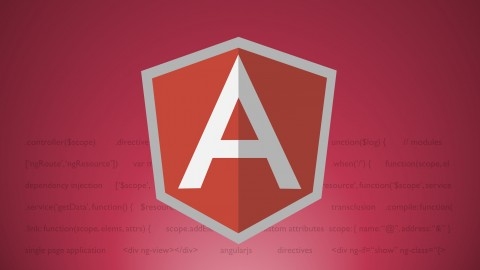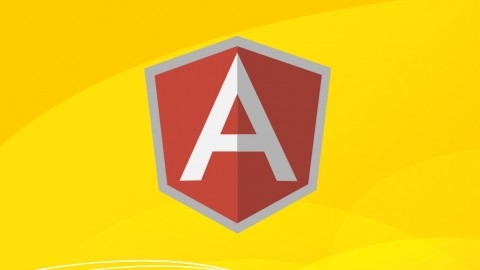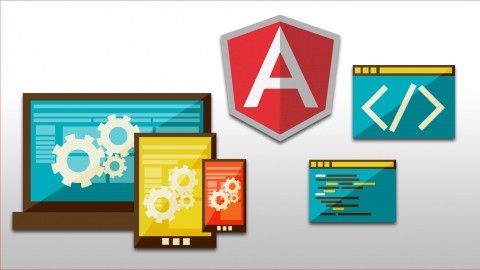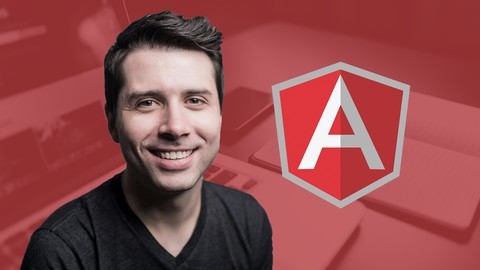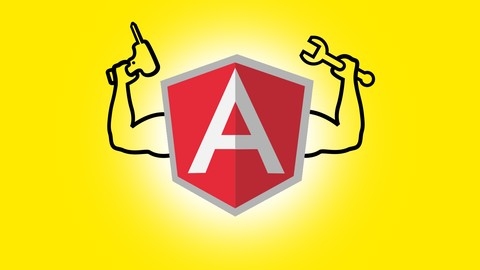Learn and Understand AngularJS
You’ll start by understanding the core concepts behind AngularJS, such as the Model-View-Whatever architecture and how it solves common problems in web development.
From there, you’ll dive into modules, apps, and controllers - the building blocks of Angular applications.
The course covers services and dependency injection in-depth, essential concepts for writing modular and testable code.
You’ll learn about data binding, directives, and how Angular’s digest loop keeps your views in sync with your models.
As you progress, you’ll explore more advanced topics like custom services, directives with different types of scope bindings, transclusion, and the compile and link functions.
The course even includes a section on building a full-fledged single page weather forecast application, putting your newfound skills into practice.
Along the way, you’ll gain a solid understanding of core JavaScript concepts like functions, arrays, the event loop, and XMLHttpRequests - knowledge that will serve you well beyond just Angular.
The course also touches on performance considerations like minification and preparing for Angular 2.
AngularJS JumpStart with Dan Wahlin
You will start by understanding the concept of Single Page Applications (SPAs) and how AngularJS facilitates building them.
The course begins with an overview of key AngularJS features like controllers, scope, views, routes, factories, and services.
You’ll learn how these components work together through hands-on coding examples that you can follow along with.
Next, you’ll dive into data binding, which is a core concept in AngularJS.
You’ll see how it saves time by automatically keeping your views and models in sync.
The course covers directives, which are markers in HTML that tell AngularJS to render or behave in a certain way.
You’ll learn about built-in directives like ng-repeat for iterating over data, as well as how to use filters for formatting and sorting data dynamically.
Controllers are critical in AngularJS, so you’ll learn their role, how to create them, and how they use scope for data binding.
You’ll also learn about modules, which are containers for your app’s components, and how to add controllers to them using techniques like “controller as” syntax.
Routing is essential for SPAs, so the course teaches you how to configure routes using $routeProvider and the ng-view directive.
This allows you to map URLs to different views and controllers in your app.
The course covers factories and services, which encapsulate reusable code to be shared across components.
You’ll learn to create them, inject them into controllers, and use built-in services like $http for making Ajax calls to a back-end RESTful service built with Node.js Express.
To enhance the user interface, you’ll learn how to use Bootstrap CSS classes and AngularJS animations with CSS transitions.
This adds a professional look and feel to your app.
Finally, there are bonus sections on building custom directives, which are one of AngularJS’s most powerful features.
You’ll learn about shared scope, isolate scope, the link() function, and best practices from a series of articles.
AngularJS Crash Course for Beginners
The course starts by introducing you to Angular JS.
You’ll learn what Angular JS is and how to create an Angular app using JSFiddle, an online code editor.
Next, you’ll dive into data binding, a core concept in Angular JS that allows you to sync data between your HTML and JavaScript.
You’ll learn how to create controllers and build simple apps with them, including apps with multiple rows of data and scope binding.
The course then covers CRUD operations (Create, Read, Update, Delete) with scope binding, giving you hands-on experience with building interactive web applications.
You’ll also learn how to use Angular JS in an IDE (Integrated Development Environment) for more advanced projects.
After mastering the basics, the course moves on to advanced topics like the Angular HTTP service, which allows you to make HTTP requests and work with remote data.
You’ll learn how to handle dependencies in Angular applications and combine binding, validation, and directives to create robust and user-friendly interfaces.
The course also covers custom directives, a powerful feature in Angular JS that allows you to create reusable components.
You’ll learn how to create custom directives and how to work with scope in custom directives.
Throughout the course, you’ll have opportunities to reinforce your learning with quizzes and hands-on exercises, ensuring that you fully understand the concepts before moving on to the next topic.
Protractor: End to End testing framework for AngularJS Apps
You will start by setting up the necessary prerequisites, including installing JDK, Node.JS, and configuring Protractor on Windows or MAC OS X environments.
Next, you will dive into the fundamentals of JavaScript, covering variables, operators, data types, control statements, functions, arrays, and objects.
This solid foundation will prepare you for understanding Protractor’s core concepts, such as the configuration file (conf.js), test structure (describe and it blocks), handling dropdowns, and validations using Jasmine’s expect statements.
The course then explores advanced topics like Promises, async/await, Jasmine’s features (beforeEach, afterEach, test suites), and locating elements using various AngularJS locators (by model, className, binding, repeater, and more).
You will also learn to automate non-Angular elements, handle alerts, iframes, tabs, and popups using the switchTo functionality.
To enhance your testing experience, you will learn to generate logs using Winston NPM, create interactive HTML reports with Allure Reports, Protractor beautiful reporter, and HTML-Reporter2 NPM.
Additionally, you will explore data-driven testing techniques, reading data from JSON files, Excel files, and parameterization using Jasmine Data Providers.
The course includes a real-world AngularJS banking application project, where you will practice end-to-end testing, implement the Page Object Model design pattern, and handle tabs and popups.
You will also learn to execute tests on an Android device and integrate with Jenkins for Continuous Integration (CI).
Furthermore, you will dive into Docker and Selenium Grid integration for parallel test execution across multiple browsers.
The course covers the Cucumber JS BDD framework, including feature files, step definitions, data tables, tags, hooks, and generating HTML reports.
You will also learn about Chai and Chai as Promised for assertions and reporting failures.
Finally, the course introduces you to Webservices and REST API testing using Protractor, covering SOAP vs. REST, CRUD operations, HTTP methods, and the importance of API testing.
AngularJS For .Net Developers From Scratch
You’ll start by learning the basics of AngularJS, including an introduction to the framework and how to get started with it.
The course then dives into core concepts like directives, modules, controllers, and services.
You’ll learn how to create controllers with methods, handle parameters, and make server calls using the $http service.
The course also covers data binding to list controls, working with cascading dropdowns and grids, applying filters, customizing grids, and implementing search, sort, and pagination functionality.
This will give you a solid understanding of how to work with data in AngularJS applications.
Moving on, you’ll learn about creating services using different methods, as well as performing CRUD operations.
The course covers advanced CRUD topics like handling date types, implementing multi-select and multi-delete in grids, and more.
Form validations are an essential part of any web application, and this course covers both client-side and server-side validations in AngularJS.
You’ll learn about various validation techniques and how to implement them.
The course also covers routing and views, which are crucial for building single-page applications.
You’ll learn how to create directory structures, configure routes and views, and handle routing with server calls.
Finally, the course delves into web storage concepts, including the $rootScope object, cookies, sessionStorage, and localStorage.
You’ll learn how to use these features to manage data in your AngularJS applications.
Projects in AngularJS - Learn by building 10 Projects
In this course, you’ll build 10 projects using AngularJS, covering diverse use cases, working with popular tools and integrating with third-party APIs like Facebook and Instagram.
It starts with an introduction to Angular and building a basic website.
You’ll then move on to more advanced projects like a web template store, a Facebook app called ngSocial, and a job directory using the MEAN stack.
The course covers building a knowledge base with Node.js and MongoDB, implementing user authentication with Sails, and creating an Instagram gallery.
You’ll also learn to build a real-time chat application with PubNub and an auto-finding app called AutoFind using MeanJS.
Throughout the projects, you’ll gain hands-on experience with Angular concepts like controllers, views, routing, services, and interacting with APIs.
You’ll work with popular tools and technologies like Plunkr, Angular Seed, Yeoman, MongoDB, and Node.js.
The projects are designed to be practical and cover a wide range of use cases.
For example, in the ngSocial app, you’ll implement Facebook login, display user info and posts, and allow posting from within the app.
In the job directory, you’ll build the entire backend job API and frontend controller.
With each project, you’ll follow a structured approach - first understanding the basic design, then implementing the core functionality, and finally adding advanced features.
The course also includes quizzes at the end of each chapter to reinforce your learning.
Ultimate AngularJS: Build a Real-World App from Scratch
You’ll start by learning the fundamentals of AngularJS, including its core concepts like controllers, scope, dependency injection, and directives.
The instructor, Ryan, will walk you through setting up your development environment and introduce you to the tools you’ll need, such as a text editor, terminal, and Node.js.
Once you have the basics down, you’ll dive into building the structure of the application.
This includes creating a toolbar, classified card, and implementing features like ng-repeat and filters.
You’ll also learn how to work with remote data using $http and promises, as well as how to implement CRUD (Create, Read, Update, Delete) operations.
The course covers advanced topics like routing with UI Router, where you’ll learn how to set up routes, switch to the “controller as” syntax, and refactor your application.
You’ll also explore watchers and emitting data between components.
To add a backend to your application, the course teaches you how to use Firebase, a popular real-time database.
You’ll learn how to read, add, edit, and delete data from Firebase, giving your application a robust backend.
The course also dives into directives, a powerful feature of AngularJS that allows you to create reusable components.
You’ll learn how to isolate scope and create a directive for the classified card component.
Finally, you’ll get a preview of Angular 2, the next version of the framework.
The instructor will cover the differences between Angular 1.x and Angular 2, as well as how to set up and wire up components in Angular 2.
Throughout the course, you’ll be building a real-world application, giving you hands-on experience with AngularJS and the various concepts covered.
With Ryan’s guidance, you’ll gain a solid understanding of AngularJS and be able to build robust, scalable applications.
Unit Testing AngularJS: Build Bugfree Apps That Always Work!
You will start by learning the importance of testing and the different types of testing.
The course then dives into setting up a basic Angular app and configuring the Karma test runner.
From there, you will learn how to write your first unit test and explore testing techniques for various Angular components.
You will learn to test controllers and the $scope object, handling XHR calls, timeouts, promises, filters, services, and directives.
The course also covers debugging Karma and understanding test coverage to ensure your tests are comprehensive.
Additionally, you will learn advanced techniques like mocking dependencies using $provide and testing events and function calls using spies.
Throughout the course, you will gain hands-on experience by writing tests for a sample Angular application.
By the end of the course, you will have a solid understanding of unit testing in AngularJS and the skills to write robust, bug-free applications that always work as expected.
AngularJS Custom Directives with Dan Wahlin
You will start by learning the basics of directives, including their role and how to create a simple “Hello World” directive.
Next, you’ll dive into shared and isolate scope, exploring how they work and how to use different types of local scope properties like @, =, and &.
The course covers the important link() function, demonstrating how to use it to build directives like TableHelper and integrate with Google Maps.
You will also learn about using controllers within directives, replacing link() with a controller, and working with controllerAs.
Transclusion is covered, showing you how to use it in directives like TableHelper.
The bonus content is particularly valuable, with examples of building custom validation directives with $asyncValidators (wcUnique), creating an Ajax overlay directive (wcOverlay) with HTTP interceptors, and implementing a menu highlighter directive.
You’ll even build a custom validator directive.
Throughout the course, you’ll work with a code editor and have access to the course code and slides.
The course assumes some prerequisites, but it guides you step-by-step through creating powerful AngularJS directives for your applications.
Essential JavaScript, jQuery and AngularJS Training
The course starts with an introduction to JavaScript, covering essential concepts like data types, operators, strings, numbers, conditionals, loops, arrays, and functions.
You’ll learn about scope, hoisting, declarations, expressions, anonymous functions, callbacks, closures, and more.
Once you have a solid foundation in JavaScript, the course dives into jQuery.
You’ll learn how to use selectors, events, effects, and traversal methods.
The course also covers advanced jQuery features like drawing, mouse position tracking, event recording, and UI elements like dialogs, datepickers, and special effects.
The main focus, however, is on AngularJS.
You’ll start by learning what AngularJS is and how to create an Angular app.
The course covers data binding, controllers, scope binding, and CRUD operations.
You’ll learn how to use Angular in an IDE project and explore advanced topics like the HTTP service, dependencies, combining binding with validation and directives, and creating custom directives.
Throughout the course, you’ll work with demo files and complete quizzes and assessments to reinforce your learning.
The instructor provides clear explanations and examples, making it easy to follow along and understand the concepts.
